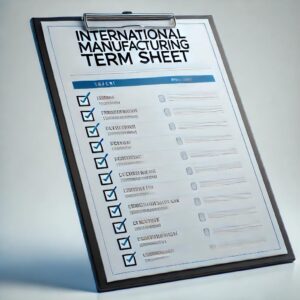Sol Gel Alumina-based Ceramic Abrasive Grains from China
On November 25, 2024, new antidumping (AD) and countervailing duty (CVD) petitions were filed against imports of sol gel alumina based ceramic abrasive grains from China. Ceramic abrasive grains are used as backings (i.e., sandpapers, grinding wheels, grinding cylinders, grinding discs, etc.) for high-precision manufacturing tools.
The petition was filed by one U.S. producer, Saint-Gobain Ceramics & Plastics, Inc. Saint-Gobain notes that it is one of the largest importers of the subject merchandise, but still chose to file this petition against all the other Chinese producers. The total imports from China in 2023 was only 807,589 kg and $2,229,773.
These AD/CVD investigations will be conducted by two federal agencies. The International Trade Commission (“ITC”) will investigate whether the subject imports have materially retarded the establishment of the domestic industry. The U.S. Department of Commerce (“DOC”) will investigate whether the subject imports are being sold to the United States at less than fair value (“dumping”) or benefit from unfair government subsidies. Both agencies have to make affirmative findings of material retardation (ITC) or of dumping or subsidies (DOC) in order for AD/CVD duties to be imposed on the subject imports.
Scope
The merchandise covered by this investigation is sol gel alumina-based ceramic abrasive grains which are comprised of minimum 94% aluminum oxide (Al2O3), and may contain other compounds, including, but not limited to, titanium dioxide, silicon dioxide, calcium oxide, sodium superoxide, ferric oxide, magnesium oxide, di-aluminum magnesium tetroxide, zirconium dioxide, or zirconium carbonate. Grain sizes of sol gel alumina-based ceramic abrasive grains range from 0.85 mm to 0.0395 mm (which corresponds to ANSI grit sizes from 20 to 280).
The sol gel alumina-based ceramic abrasive grains’ defining crystalline microstructure, as well as their irregular shapes, make them well suited for advanced abrasive applications, as compared with conventional fused grains. The shapes may be angular, sharp, extra sharp, blocky, splintery, round stripped, triangular or shaped like extruded rods or stars. The hardness ranges between 16 and 22 gigapascals by the by Vickers Diamond Indent Method. The microstructure crystalline size ranges from 0.1 to 30 µm. These ceramic abrasive grains come in blue, white, white-translucent, or off-white opaque colors.
Ceramic abrasive grains are exclusively manufactured through a “sol gel” process which creates the ceramic’s unique, defining crystalline structure and imparts certain advanced properties that distinguish ceramic abrasive grains from conventional fused abrasive grains, such as extreme hardness and strength, resistance to abrasion and chemicals, high melting point, high thermal conductivity, high degree of refractoriness, high dielectric strength, and high electric resistivity at elevated temperatures.
Sol gel alumina-based ceramic abrasive grains are covered by the scope of this investigation, whether or not incorporated into downstream articles, including but not limited to, abrasive papers, grinding wheels, grinding cylinders, and grinding discs. When incorporated into downstream articles, only the sol gel alumina-based ceramic abrasive grains component of such articles is covered by the product scope, and not the downstream product as a whole.
The merchandise subject to these investigations is properly classified under subheading 2818.10.2090 and2818.10.2090 of the Harmonized Tariff Schedule of the United States (HTSUS). Other merchandise subject to the current scope, including when incorporated into the abovementioned downstream articles, may be classified under HTSUS subheadings 2818.10.1000, 2818.20.0000, 2818.30.0000, 3824.99.1100, 3824.99.1900, 6804.22.1000, 6804.22.4000,6804.22.6000, 8204.12.0000, 8474.90.0010, 8474.90.0020, 8474.90.0050, and 8474.90.0090.Although the HTSUS statistical reporting numbers are provided for convenience and customs purposes, the written description of the merchandise is dispositive.
Alleged AD/CVD Margins
Petitioner calculated an estimated dumping margin of 176.15%.
Petitioner did not provide any specific subsidy margin calculations.
Named Exporters/ Producers
Petitioner included a list of companies that it believes are producers and exporters of the subject merchandise. See attached list of exporters here.
Named U.S. Importers
Petitioner included a list of companies that it believes are U.S. importers of the subject merchandise. See attached list of importers here.
Estimated Schedule of Investigations
November 25, 2024 – Petitions filed
December 15, 2024 – DOC initiates investigation
December 16, 2024 – ITC Staff Conference
January 9, 2025 – ITC preliminary determination
April 24, 2025 – DOC CVD preliminary determination (assuming extended deadline) (2/18/25 – unextended)
June 23, 2025 – DOC AD preliminary determination (assuming extended deadline)
(5/4/25 – unextended)
November 5, 2025 – DOC final determination (extended)
December 20, 2025 – ITC final determination (extended)
December 27, 2025 – DOC AD/CVD orders issued (extended)

























